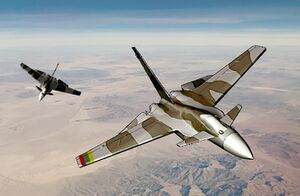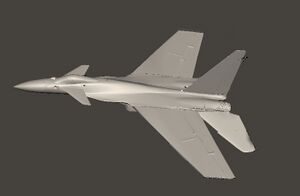AC-88 Taipan
| AC-88 Taipan | |
|---|---|
 AC-88 Taipan Block II fighters over Bashriyyan-Tifyan Border, 2018 | |
| General information | |
| Type | Air-Superiority Fighter |
| Manufacturer | Incorporaçion Estavez-Colón (IEK) |
| Status | In service |
| History | |
| Manufactured | 1997-present |
| Introduction date | 1998 |
The AC-88 Taipan is an air-superiority fighter developed by Inyursta for the Inyurstan Air Force, and later Inyurstan Navy. It is named after the Taipan, a genus of highly venomous and formidable snakes.
As a dedicated air-superiority fighter that has seen widespread service, it is both one of the most famous and one of the most feared aircraft in the Inyurstan arsenal.
Development
The Taipan program began as an indigenous effort to develop a 4th-Generation "pure" air-superiority fighter along the same lines as the original F-15. Designers and engineers also borrowed the same phrase "not a pound for air-to-ground" when describing the duties and expected roles of the Taipan. In December of 1996, the original X-88 prototype made its maiden flight, performing several sonic booms, Herbst Maneuvers and Pugachev's Cobra. It was soon after ordered into production and adopted by the Inyurstan Air Force.
However, even after the Taipan entered service, the program continued development. Part of this was due to limited access to forthcoming technologies (AESA radar, IRST, etc.), and in part due to air-to-air lessons learned in the trial-by-fire crucible that was the Lolloh-Ruol Wars. Incorporation of these upgrades, while long-coming, was made easier by the initial designers leaving "empty space" both physically and in terms of software code, with the intent of adding plug-and-play additions in the future.
Design
Main design features of the Taipan include swept wings, a single vertical tail, and the presence of forward canards and a Leading Edge Extension (LERX). Swept wings allow the AC-88 greater wing loading, stable center of lift, and a smoother transition between subsonic and supersonic speeds. To compensate for the increased drag caused by the swept-wings, a single all-movable tail is situated between the two engines, giving it less drag during straight-forward supersonic flight than would two vertical tail. At high angles of attack, both the canards and LERX are used to reduce the effect of the fuselage "blocking" the tail fin and keep airflow over the tail.
Later models also feature a forward air brake and thrust-vectoring engines; all features which give it super-maneuverable capabilities.
Power
Early AC-88 used CP-1990 conventional turbofan jet engines. However, because these engines were produced at the infancy of the Inyurstan arms industry development, with little external support or input, they were not optimized to make the most of available technologies or thrust output. This is not to say that the engines were ineffective, but later on IEK would secure the sale of Nifonese Kojima K50 variable-cycle engines for the Block II line which would power the Taipan with over 170kn wet thrust (112kn dry), giving it supercruise capability, among other enhancements to its aerial maneuverability. The K-50 engines also allowed for increased kW generation, which allowed the Block II+ models to support their more diversified array of avionics.
Avionics
Original models carried the ESQ/AS-1 Razor radar, an infant project giving the Taipan a radar range of roughly 100km against 3m2 targets and without IRST systems; however both features would later be improved upon with future models. The Block II upgrades featured significant improvements; including new radar, radar-warning receiver (RWR), IRST systems, helmet-mounted-display, and additional RWR/MLD antennae & nodes.
For its primary radar, Block II+ models of the AC-88 use the ESQ/AS-7 Yaraca, an impressive solid-state AESA X-Band radar. The ESQ/AS-7 is capable of tracking up to six individual 1m2 targets at ranges of up to 200-400km, depending on beam width. The nose-mounted ESQ/AS-7 can rotate approximately +/- 25o, when paired with the wide-band capabilities this can allow the Taipan to track targets at angles approaching perpendicular. A secondary pair of lightweight ESQ/AS-A-8 L-band AESA radars are also installed bellow the LERX allowing for enhanced detection of stealth targets and redundancy during high-EW situations.
Infrared tracking & targeting capabilities are provided by the CAT EYE I passive IRST, which are linked to the pilot's HMSD. The main node is located under the nose, while additional censors are installed one under the fuselage and two on either side of the tail facing up and backwards. Additional nodes are also fed into the plane's targeting software, allowing for tracking and engagement of highly maneuverable aerial targets (especially those performing post-stall maneuvers) even when they have escaped into the pilot's blind spots.
Current models of the AC-88 are equipped with the LIDACS-II Counter-Measure Suite, a multitool of counter-measure options including chaff, flares, two IR Jamming/dazzler nodes and ECM/DRFM jamming. This system is synchronized with the Taipan's ESQ/CE-11 radar warning receiver (RWR)/missile launch detector (MLD); a system of 16 (Block I) - 28 (Block II) antennae streamlined through the body and three infrared sensors (no display) filling the gaps in coverage left by the CAT EYE system. It can also aid in detection of enemy aircraft (such as AWE&CS or powerful fighter radars) when the Taipan is being "painted" with radar beams.
History
The Lolloh-Ruol Wars became the first conflict for the Taipan's to see combat. They proved quite successful at surviving onslaughts of both Cold War-era relic fighters and modern 4.5 and 5th-gen aircraft in both medium-range ("short BVR") and short-range engagements.
See also: Air Battle of Dekkar
Due to the lessons learned in the Lolloh-Ruol Wars, designers and military strategists began scheming with the idea of using the Taipan as an interceptor to destroy bombers and C4ISTAR assets. Tests were done with the American AIM-54 Pheonix integrated onto the AC-88, and such load outs saw limited use in combat; however, they would later pave the way for the integration of the C-300 Scapèle onto the aircraft.
In the Greco-Bulgarian War they were deployed but to limited use and effect due to the relative lack of hostile air targets.
The AC-88E Taipan Block II made its debut and served as the backbone of Inyurstan support during the DEN Invasion of Colombia.
AC-88E Taipan's were responsible for the interception of two Hayesalian CBU-160 Super Blackjack bombers during the San Meresque Incident.
Maneuvers
Aerial Scorpion
The "Aerial Scorpion" is a multi-plane (requiring 3-6 fighters) maneuver for BVR against an approaching enemy.
Fire Flower
The "Fire Flower" is a last-ditch WVR maneuver that was first observed during the Air Battle of Dekkar. It is performed by a single, outnumbered fighter against multiple enemies within visual range.
Variants
X-88: Radar-less technology demonstrator
AC-88A: Standard model put into production 1997.
AC-88A2 Block I+: Added additional IRST systems and allowed off-boresight capabilities.
AC-88E Block II: Added improved engines and ESQ/AS-7 radar, conversion & production began in 2006.
AC-88ACF Block III "Super Taipan": Proposed legacy upgrade which would feature lower RCS, electronic warfare capabilities and increased payload.
Specifications
Crew: 1
Speed: Mach 2.25 (1667.46mph; 2683.52km/h)
Combat Radius:
- 850km on Internal Stores with x8 AAMs
- 1,100km with x2 400gal drop tanks and x8 AAMs
- 1,300km with x2 400gal & x1 600gal drop tanks and x4 AAMs
Ferry Range: >3,000km
Max Climb Rate: 18,900 m/min - 62,000 ft/min
Wing Area: 62.6m2
Empty Weight: 32,000lb; 14,500kg (1.57 T/W)
Gross Weight: 55,000lb; 24,900kg Internal fuel + 10 missiles (0.92 T/W)
Max Takeoff Weight: 69,000lb; 31,300kg (0.7 T/W)
Internal Fuel Capacity: 17,600lbs; 7,980kg (approx 2,620gal)
| Weight | Payload | Thrust-Weight Ratio | Wing Loading |
|---|---|---|---|
| 50% Internal Fuel | x6 AAMs | 1.17 | 309.7kg/m2 |
| 100% Internal Fuel | x10 AAMs | 0.95 | 382.5kg/m2 |
| 100% Internal Fuel | x2 400gal drop tanks, x6 AAMs | 0.88 | 414kg/m2 |
| 100% Internal Fuel | x2 400gal drop tanks, x1 600gal drop tank, x4 AAMs | 0.83 | 440kg/m2 |
Hardpoints:
- x3 Undercarriage
- x4 Underwing
- x2 Wingtip
Armament
Gun: RK-23-1 "Venom" 23mm Gatling Gun
Air-to-Air Missiles:
